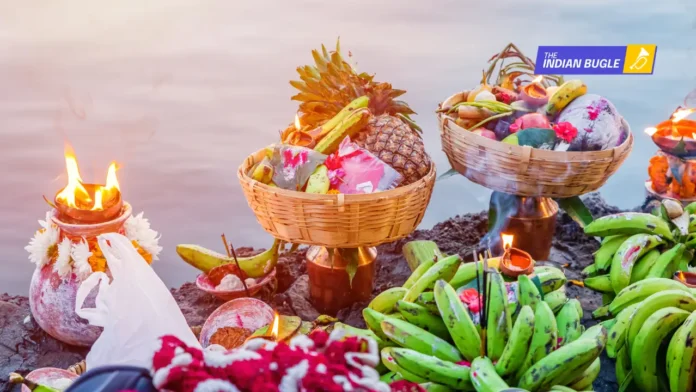Chhath Puja, also known as Surya Shashthi or the Mahāparv of the Sun God, is one of the most ancient and spiritually powerful festivals celebrated in Bihar, Jharkhand, Eastern Uttar Pradesh, and Nepal’s Terai region.
This festival is dedicated to Lord Surya (the Sun God) and Chhathi Maiya (Shashthi Devi), the goddess who is believed to bestow health, prosperity, and longevity upon her devotees.
Chhath is unique among Hindu festivals because it involves direct worship of nature — the setting and rising sun — without the use of idols. It emphasizes purity, discipline, gratitude, and harmony between humanity and the environment.
Celebrated twice a year — Chaiti Chhath (March–April) and Kartik Chhath (October–November) — the latter is the grander festival observed after Diwali.
When is Chhath Puja in 2025?
In 2025, Kartik Chhath Puja will be observed from Saturday, October 25 to Tuesday, October 28.
| Day | Date (2025) | Ritual |
|---|---|---|
| Day 1 | Saturday, October 25 | Nahay Khay |
| Day 2 | Sunday, October 26 | Kharna (Lohanda) |
| Day 3 | Monday, October 27 | Sandhya Arghya (Evening Offerings to the Setting Sun) |
| Day 4 | Tuesday, October 28 | Usha Arghya (Morning Offerings to the Rising Sun) |
The most important rituals — Sandhya Arghya and Usha Arghya — will be performed on October 27 and 28, marking the culmination of this sacred festival.
Day-by-Day Rituals of Chhath Puja
Day 1: Nahay Khay (Bath and Eat)
The first day of Chhath is about purification and preparation.
- Devotees begin their day with a holy bath in rivers, ponds, or clean water bodies — especially the Ganga or local ghats.
- Homes are thoroughly cleaned to invite positivity and purity.
- A simple satvik meal (without onion, garlic, or salt) is prepared — often consisting of rice, bottle gourd, and lentils (Chana Dal) cooked in pure ghee.
- This marks the start of the spiritual journey, as devotees commit to maintaining cleanliness, honesty, and self-control throughout the festival.
Symbolism:
Nahay Khay symbolizes the purity of the body and mind, preparing devotees for the upcoming fasts.
Day 2: Kharna (Lohanda)
The second day is known as Kharna, a day of strict fasting and self-discipline.
- Devotees observe a day-long fast without food or water.
- In the evening, after sunset, the fast is broken with offerings of gur ki kheer (rice pudding made with jaggery), roti, and banana.
- This meal, called Kharna prasad, is shared with family and neighbors as a symbol of love and purity.
- After Kharna, the devotee begins a 36-hour nirjala vrat — a fast without water — which continues until sunrise after Usha Arghya.
Symbolism:
Kharna represents self-restraint, gratitude, and purification of the soul. It’s believed that this fast cleanses both the body and mind, preparing devotees for divine communion.
Day 3: Sandhya Arghya (Evening Offerings to the Setting Sun)
The third day is the most important and visually mesmerizing part of Chhath Puja.
- Devotees and families gather at ghats or riverbanks in the evening.
- They stand waist-deep in water and offer arghya (libations) to the setting sun, accompanied by traditional folk songs and chants like “Chhathi Maiya ke Geet.”
- Offerings include thekua (a sweet made of wheat flour and jaggery), sugarcane, coconut, bananas, and seasonal fruits, arranged beautifully in bamboo baskets (soop).
- The atmosphere becomes magical — diyas float on the water, women sing devotional songs, and the air resonates with prayers for prosperity and family well-being.
Symbolism:
The Sandhya Arghya signifies gratitude to the Sun God for sustaining life on Earth and symbolizes the setting phase of life, humility, and surrender before renewal.
Day 4: Usha Arghya (Morning Offerings to the Rising Sun)
The final day of Chhath Puja begins before dawn.
- Devotees return to the riverbanks before sunrise to offer arghya to the rising sun, marking the festival’s completion.
- The rising sun symbolizes new beginnings, hope, and the continuation of life.
- After the offering, devotees break their 36-hour fast by consuming the prasad — often thekua, fruits, and holy water.
- Families share this sacred prasad with relatives and neighbors, spreading blessings and gratitude.
Symbolism:
Usha Arghya represents rebirth, enlightenment, and spiritual awakening — completing the devotee’s journey from purification to renewal.
The Spiritual Essence of Chhath
Each ritual of Chhath Puja is deeply symbolic — representing the eternal cycle of sunrise and sunset, life and death, and darkness and light.
The festival’s discipline, environmental purity, and communal unity make it one of the most eco-conscious and spiritually profound traditions in the world.
Chhath reminds us that true devotion lies in simplicity, gratitude, and respect for nature — the very forces that sustain human existence.
Chhath Puja 2025, celebrated from October 25 to 28, will once again bring together millions in collective prayer, faith, and devotion. From the first holy bath of Nahay Khay to the sunrise offering of Usha Arghya, every act during this festival is a hymn of gratitude to the Sun — the eternal life-giver.
As devotees stand in rivers with folded hands and hearts full of hope, Chhath remains not just a ritual — but a celebration of trust, nature, and the enduring spirit of humanity.
